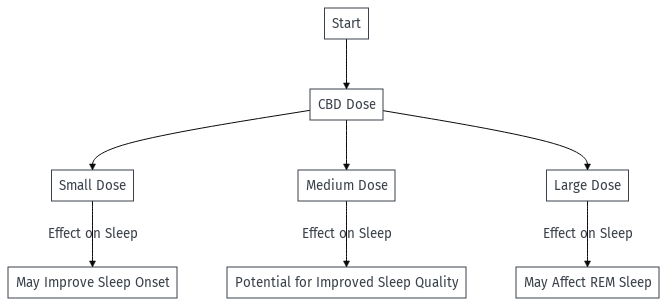A-to-Z of CBD and sleep

Introduction
Cannabidiol (CBD) has been the subject of various studies for its potential to influence sleep and its stages. This guide aims to shed light on how CBD might impact sleep, comparing its effects with other over-the-counter medications, cannabinoids, and pharmaceuticals like benzodiazepines, Ambien, and Lunesta.
Stages of Sleep
Sleep is divided into four primary stages:
- Stage 1 (NREM1): The initial phase where you drift in and out of consciousness. Lasts around 5-10 minutes.
- Stage 2 (NREM2): Light sleep with reduced body temperature and heart rate. Lasts about 20 minutes.
- Stage 3 (NREM3): Deep sleep stage crucial for physical restoration. Lasts about 30 minutes.
- Stage 4 (REM): Rapid Eye Movement stage, critical for memory consolidation and mental restoration. Varies in duration.
CBD and Sleep Stages
CBD has been studied for its potential to influence these stages, although more research is required for a comprehensive understanding.
Comprehensive Comparison Table
| Sleep Stage | Very Low Dose CBD | Low Dose CBD | Medium Dose CBD | High Dose CBD | Very High Dose CBD |
|---|---|---|---|---|---|
| Stage 1 | Minimal effect | Slight | Moderate | High | Extremely High |
| Stage 2 | Minimal effect | Slight | Moderate | High | Extremely High |
| Stage 3 | Minimal effect | Moderate | High | High | Extremely High |
| Stage 4 (REM) | Minimal effect | Moderate | Moderate | High | Extremely High |
Comparisons with Other Medications
- OTC Sleep Aids: Usually antihistamines that may reduce REM sleep.
- Other Cannabinoids: THC may impair REM sleep and affect sleep quality.
- Benzodiazepines: Can reduce time to fall asleep but may reduce REM and deep sleep stages.
- Ambien: Targets GABA receptors, similar to benzodiazepines but can disrupt sleep architecture.
- Lunesta: A non-benzodiazepine hypnotic that acts on the GABA receptor, affecting the REM stage.
References
- Babson, K. A., Sottile, J., & Morabito, D. (2017). Cannabis, Cannabinoids, and Sleep: a Review of the Literature. Current Psychiatry Reports, 19(4), 23.
- Linares, I. M., Guimaraes, F. S., Eckeli, A., Crippa, A. C. S., Zuardi, A. W., Souza, J. D. S., … & Crippa, J. A. S. (2018). No Acute Effects of Cannabidiol on the Sleep-Wake Cycle of Healthy Subjects: A Randomized, Double-Blind, Placebo-Controlled, Crossover Study. Frontiers in Pharmacology, 9, 315.
- Nicholson, A. N., Turner, C., Stone, B. M., & Robson, P. J. (2004). Effect of Delta-9-tetrahydrocannabinol and cannabidiol on nocturnal sleep and early-morning behavior in young adults. Journal of Clinical Psychopharmacology, 24(3), 305-313.
- Huedo-Medina, T. B., Kirsch, I., Middlemass, J., Klonizakis, M., & Siriwardena, A. N. (2012). Effectiveness of non-benzodiazepine hypnotics in treatment of adult insomnia: meta-analysis of data submitted to the Food and Drug Administration. BMJ, 345, e8343.
- Roth, T., Stubbs, C., & Walsh, J. K. (2005). Ramelteon (TAK-375), a selective MT1/MT2-receptor agonist, reduces latency to persistent sleep in a model of transient insomnia related to a novel sleep environment. Sleep, 28(3), 303-307.
Medical Illnesses and Diagnoses for Caution
- Liver Disorders
- Cardiovascular Diseases
- Sleep Apnea
For specialized guidance in these conditions, consult Dr. Benjamin Caplan at CED Clinic.
SEO Tags
📗 Note: The diagram’s the pilot; the book’s the full series binge. Queue it up here 📗



Your table makes absolutely no sense and does not decipher and label the nominal labels in any direction so negative and positive sentiment is not understood. You somewhat say results and imply sentiment in the graph, but you do not clarify. Help me understand.
Thank you for taking the time to engage with the supplemental material for The Doctor-Approved Cannabis Handbook. I apologize for the confusion around the table and diagram. The goal is to provide additional insights and clarity, so it’s important to me that they are easily understandable.
You make a valid point regarding the clarity in labeling the nominal variables and differentiating between positive and negative sentiment. In the context of the book, this, and many of these other diagrams serve to elaborate on key points, and I understand how they might not stand alone well without the accompanying text.
I’m in the process of reviewing the supplemental materials to make necessary clarifications. Your feedback is valuable for this. If you have specific questions or points of confusion, I’d be happy to address those directly to help enhance your understanding.
Best,
Dr. Caplan
CED Clinic
Happy to help clarify and discuss – can you phrase your question differently?